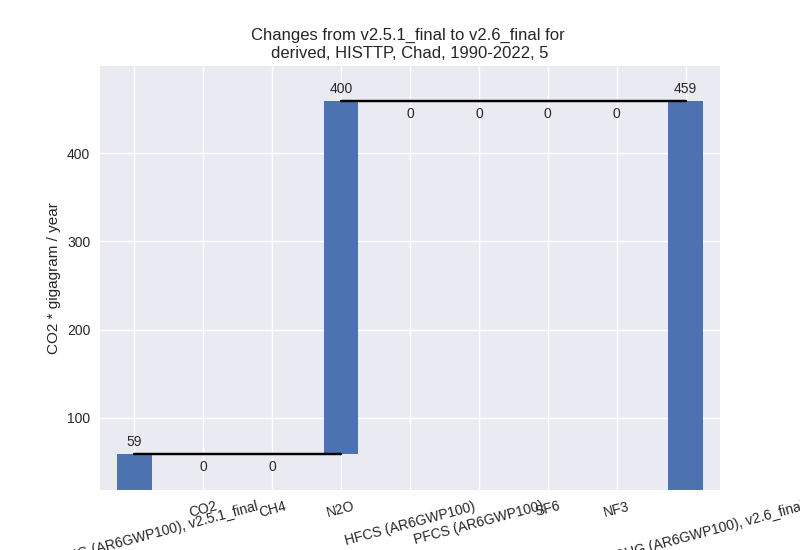Changes in PRIMAP-hist v2.6_final compared to v2.5.1_final for Chad
2024-09-24
Johannes Gütschow
Change analysis for Chad for PRIMAP-hist v2.6_final compared to v2.5.1_final
Overview over emissions by sector and gas
The following figures show the aggregate national total emissions excluding LULUCF AR6GWP100 for the country reported priority scenario. The dotted linesshow the v2.5.1_final data.
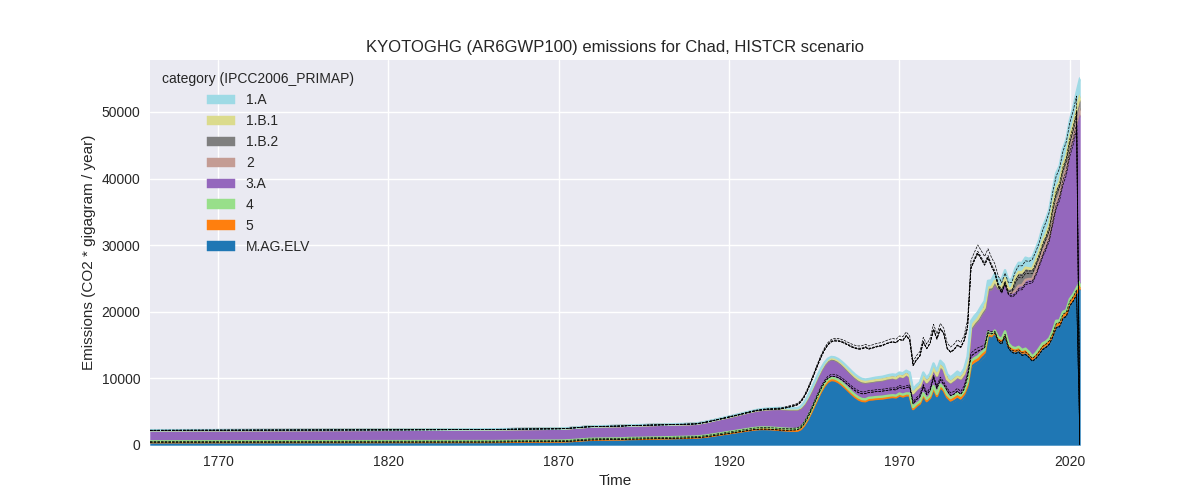
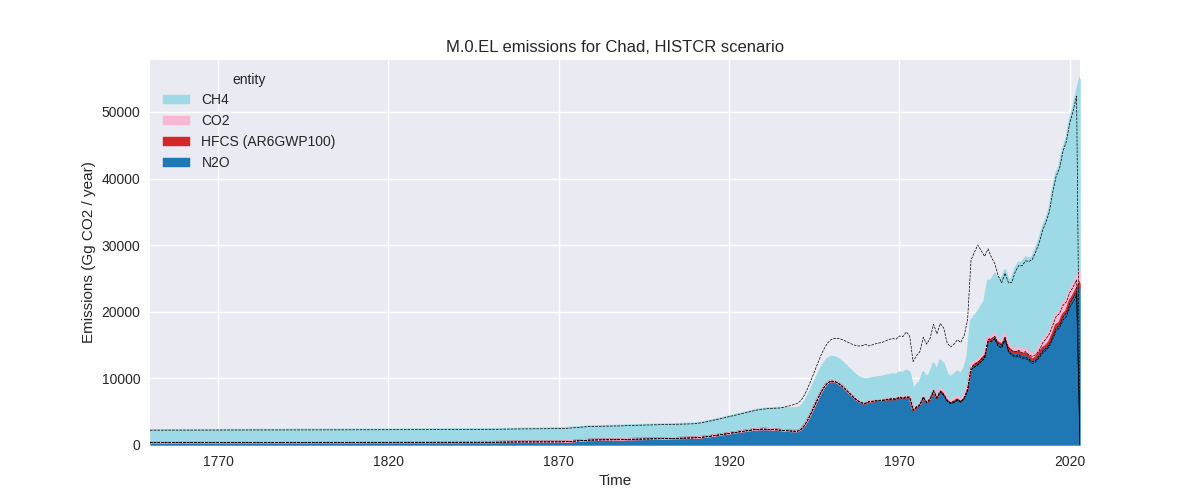
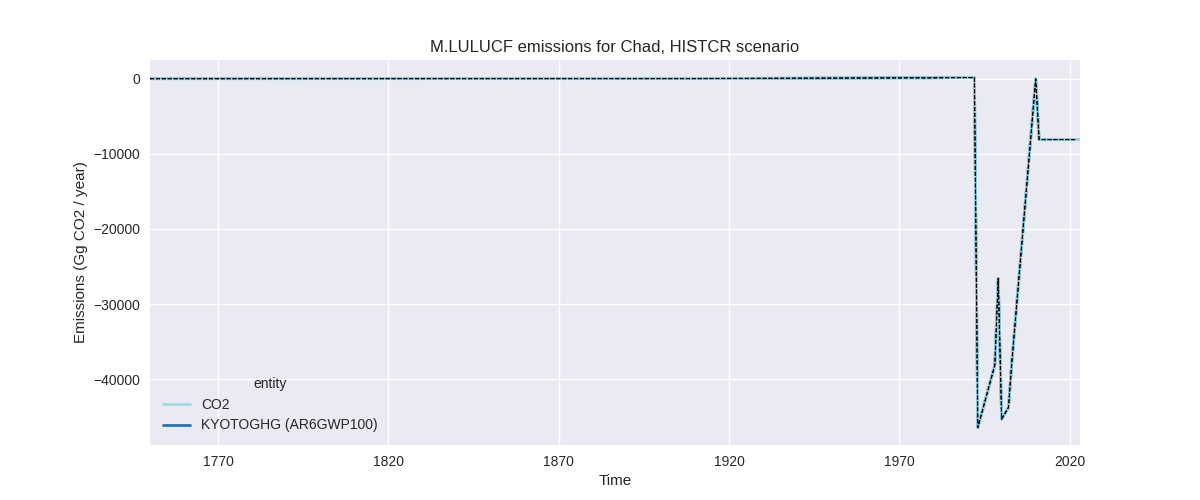
The following figures show the aggregate national total emissions excluding LULUCF AR6GWP100 for the third party priority scenario. The dotted linesshow the v2.5.1_final data.
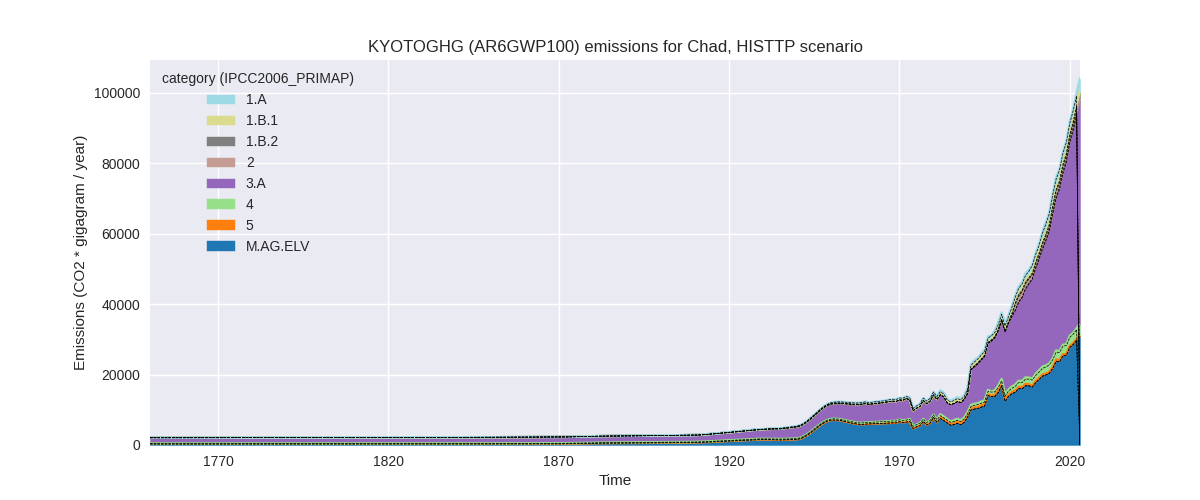
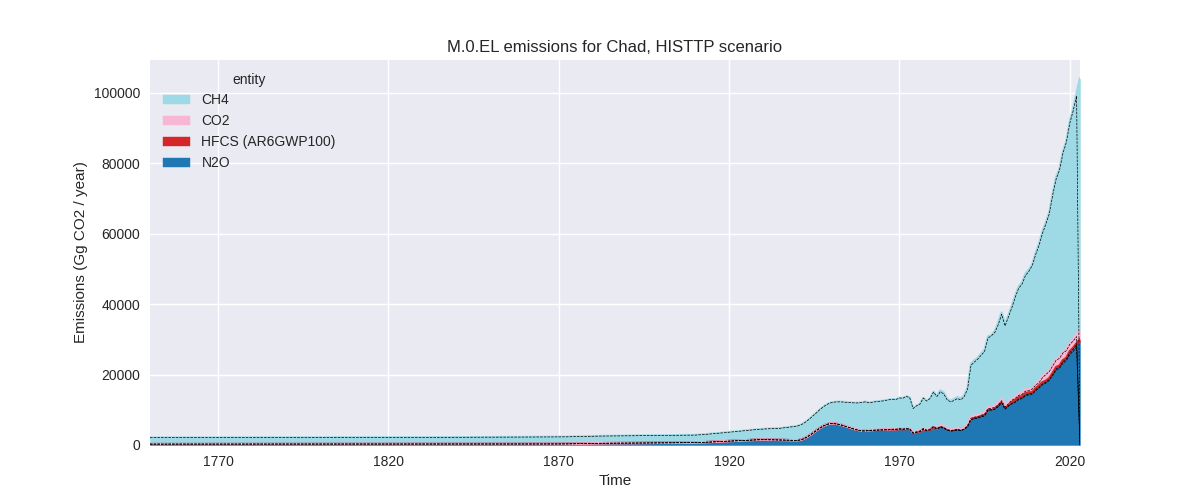
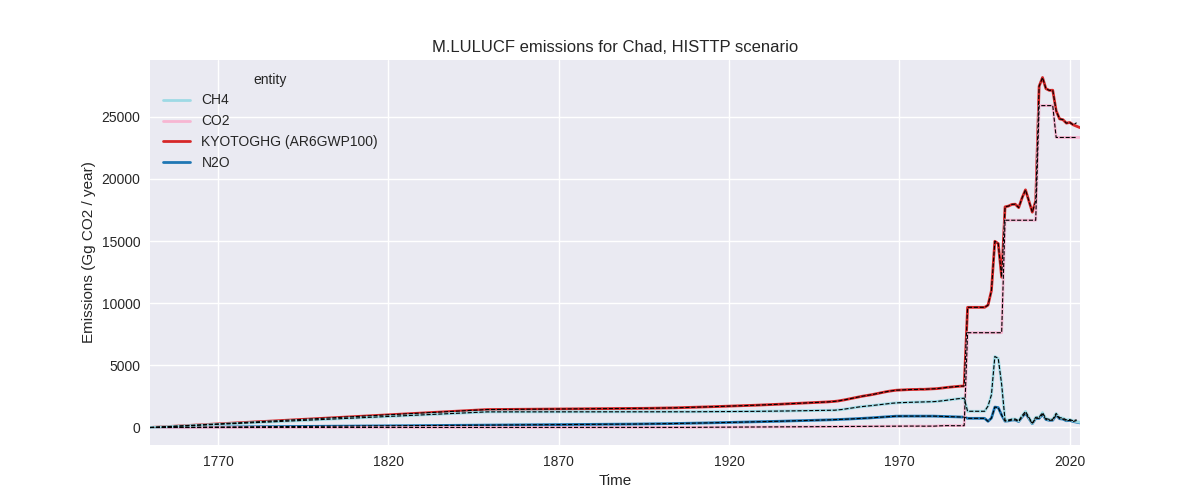
Overview over changes
In the country reported priority scenario we have the following changes for aggregate Kyoto GHG and national total emissions excluding LULUCF (M.0.EL):
- Emissions in 2022 have changed by 1.0%% (536.54 Gg CO2 / year)
- Emissions in 1990-2022 have changed by -4.8%% (-1525.55 Gg CO2 / year)
In the third party priority scenario we have the following changes for aggregate Kyoto GHG and national total emissions excluding LULUCF (M.0.EL):
- Emissions in 2022 have changed by 0.8%% (769.42 Gg CO2 / year)
- Emissions in 1990-2022 have changed by 0.9%% (440.39 Gg CO2 / year)
Most important changes per scenario and time frame
In the country reported priority scenario the following sector-gas combinations have the highest absolute impact on national total KyotoGHG (AR6GWP100) emissions in 2022 (top 5):
- 1: 5, N2O with 282.90 Gg CO2 / year (413.5%)
- 2: 1.A, CO2 with 258.30 Gg CO2 / year (27.3%)
- 3: 4, N2O with -13.77 Gg CO2 / year (-3.1%)
- 4: 2, HFCS (AR6GWP100) with 9.60 Gg CO2 / year (1.5%)
- 5: 4, CH4 with -0.50 Gg CO2 / year (-0.2%)
In the country reported priority scenario the following sector-gas combinations have the highest absolute impact on national total KyotoGHG (AR6GWP100) emissions in 1990-2022 (top 5):
- 1: 3.A, CH4 with -1602.88 Gg CO2 / year (-12.5%)
- 2: 5, N2O with 400.43 Gg CO2 / year (684.2%)
- 3: M.AG.ELV, CH4 with -330.60 Gg CO2 / year (-27.1%)
- 4: 1.A, CO2 with 9.88 Gg CO2 / year (1.6%)
- 5: 4, N2O with -2.12 Gg CO2 / year (-1.0%)
In the third party priority scenario the following sector-gas combinations have the highest absolute impact on national total KyotoGHG (AR6GWP100) emissions in 2022 (top 5):
- 1: 1.A, CO2 with 422.36 Gg CO2 / year (27.3%)
- 2: 5, N2O with 282.90 Gg CO2 / year (413.5%)
- 3: 4, CH4 with 31.35 Gg CO2 / year (1.1%)
- 4: 4, N2O with 23.20 Gg CO2 / year (11.4%)
- 5: 2, HFCS (AR6GWP100) with 9.60 Gg CO2 / year (1.5%)
In the third party priority scenario the following sector-gas combinations have the highest absolute impact on national total KyotoGHG (AR6GWP100) emissions in 1990-2022 (top 5):
- 1: 5, N2O with 400.43 Gg CO2 / year (684.2%)
- 2: 1.A, CO2 with 16.15 Gg CO2 / year (1.6%)
- 3: 4, CH4 with 13.49 Gg CO2 / year (0.8%)
- 4: 4, N2O with 10.03 Gg CO2 / year (8.5%)
- 5: 2, HFCS (AR6GWP100) with 0.29 Gg CO2 / year (0.1%)
Notes on data changes
Here we list notes explaining important emissions changes for the country. ’' means that the following text only applies to the TP time series, while means that it only applies to the CR scenario. Otherwise the note applies to both scenarios.
- “Other” N2O is much higher because we now use EDGAR instead of FAOSTAT as originally intended (CR, TP). This also leads to changes in the waste sector.
- We have removed 1993 agricultural data from UNFCCC DI data because it is inconsistent with data for other years. This has reduced cumulative agricultural emissions in the CR scenario.
- The high 2022 change in energy CO2 is from updated EI data (CR and TP).
Changes by sector and gas
For each scenario and time frame the changes are displayed for all individual sectors and all individual gases. In the sector plot we use aggregate Kyoto GHGs in AR6GWP100. In the gas plot we usenational total emissions without LULUCF. ## country reported scenario
2022
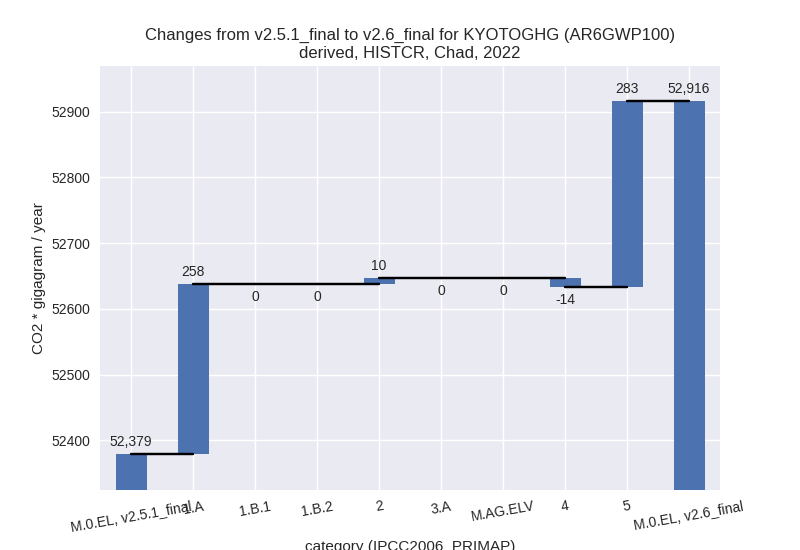

1990-2022

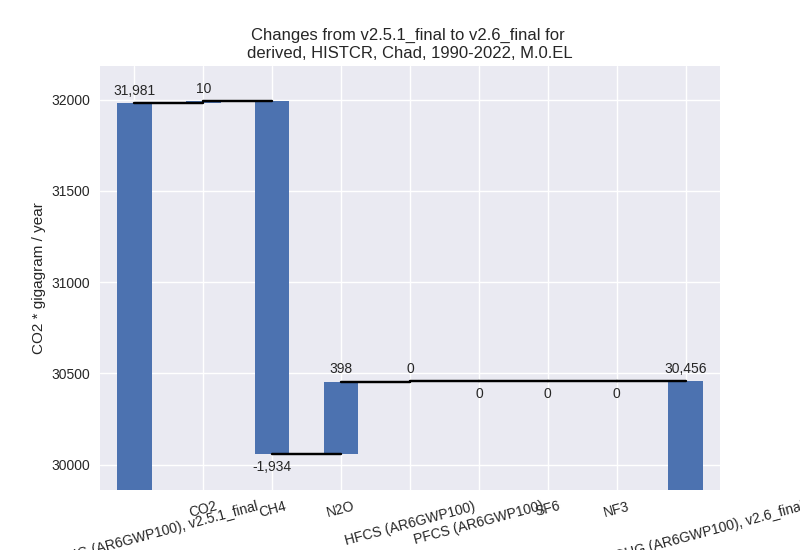
third party scenario
2022
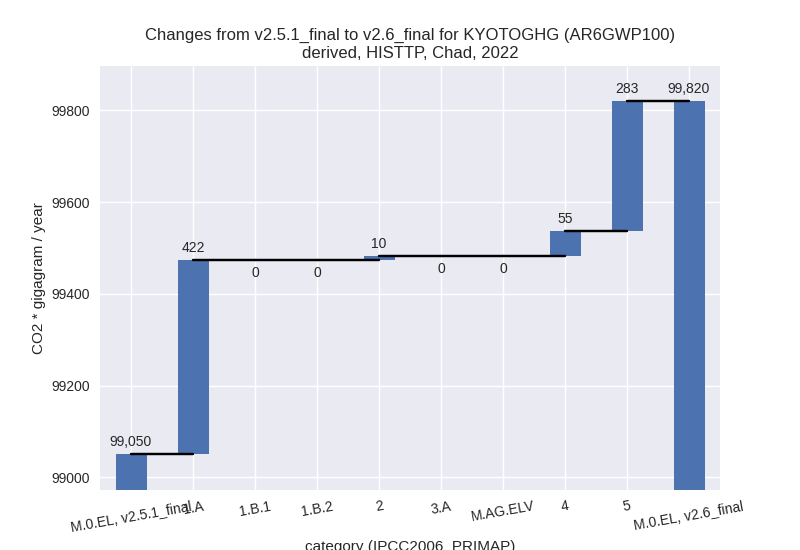
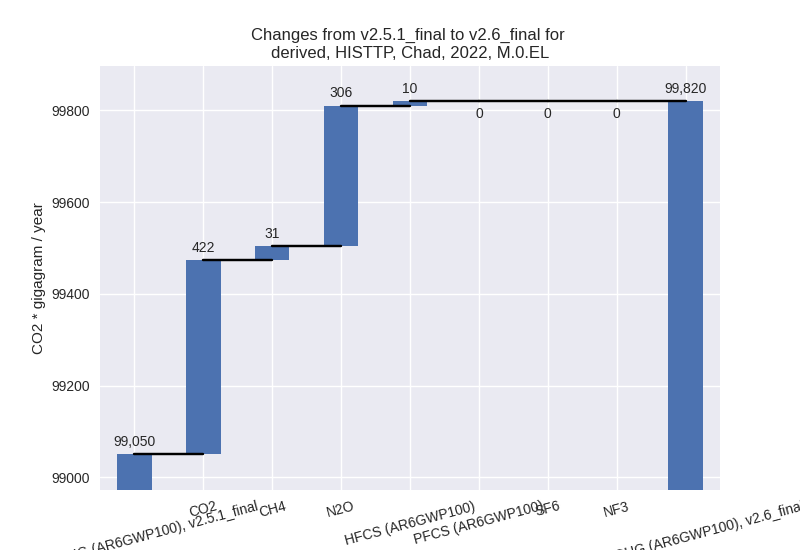
1990-2022
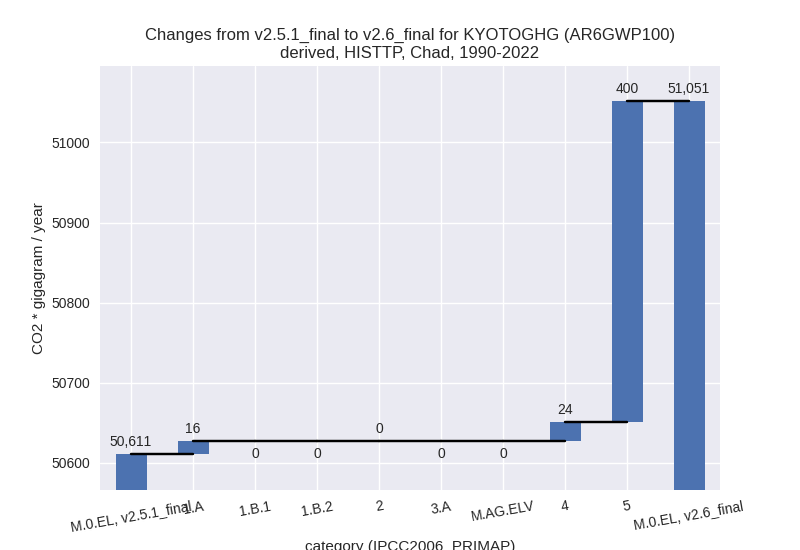
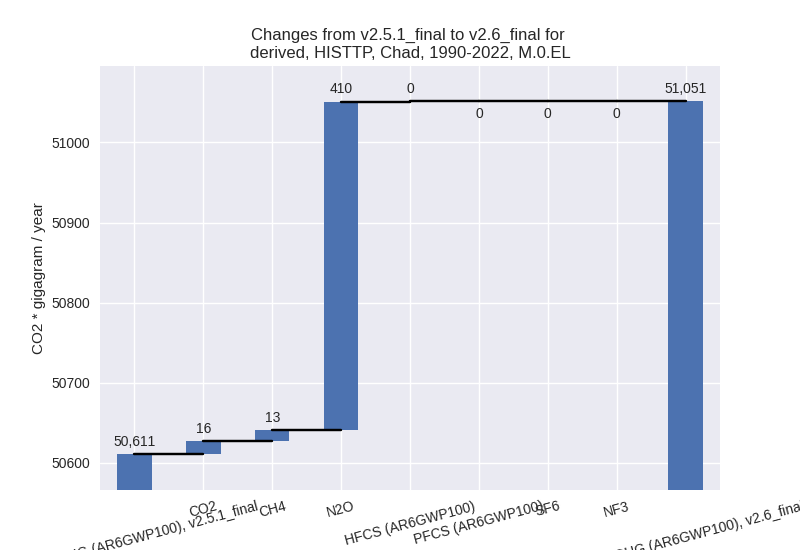
Detailed changes for the scenarios:
country reported scenario (HISTCR):
Most important changes per time frame
For 2022 the following sector-gas combinations have the highest absolute impact on national total KyotoGHG (AR6GWP100) emissions in 2022 (top 5):
- 1: 5, N2O with 282.90 Gg CO2 / year (413.5%)
- 2: 1.A, CO2 with 258.30 Gg CO2 / year (27.3%)
- 3: 4, N2O with -13.77 Gg CO2 / year (-3.1%)
- 4: 2, HFCS (AR6GWP100) with 9.60 Gg CO2 / year (1.5%)
- 5: 4, CH4 with -0.50 Gg CO2 / year (-0.2%)
For 1990-2022 the following sector-gas combinations have the highest absolute impact on national total KyotoGHG (AR6GWP100) emissions in 1990-2022 (top 5):
- 1: 3.A, CH4 with -1602.88 Gg CO2 / year (-12.5%)
- 2: 5, N2O with 400.43 Gg CO2 / year (684.2%)
- 3: M.AG.ELV, CH4 with -330.60 Gg CO2 / year (-27.1%)
- 4: 1.A, CO2 with 9.88 Gg CO2 / year (1.6%)
- 5: 4, N2O with -2.12 Gg CO2 / year (-1.0%)
Changes in the main sectors for aggregate KyotoGHG (AR6GWP100) are
- 1: Total sectoral emissions in 2022 are 4472.74 Gg
CO2 / year which is 8.5% of M.0.EL emissions. 2022 Emissions have
changed by 6.1% (258.30 Gg CO2 /
year). 1990-2022 Emissions have changed by 0.4% (9.88 Gg CO2 / year). For 2022 the
changes per gas
are:

The changes come from the following subsectors:- 1.A: Total sectoral emissions in 2022 are 2544.66
Gg CO2 / year which is 56.9% of category 1 emissions. 2022 Emissions
have changed by 11.3% (258.30 Gg CO2
/ year). 1990-2022 Emissions have changed by 0.6% (9.88 Gg CO2 / year). For 2022 the
changes per gas
are:
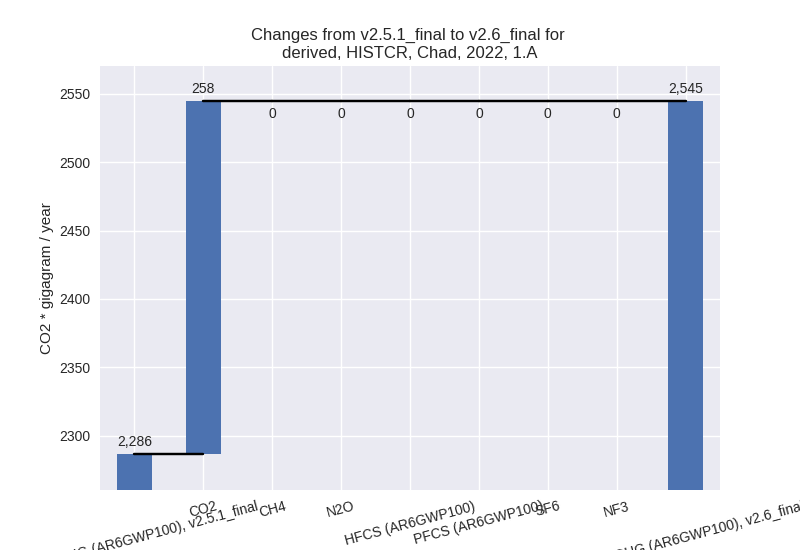
There is no subsector information available in PRIMAP-hist. - 1.B.1: Total sectoral emissions in 2022 are 564.89 Gg CO2 / year which is 12.6% of category 1 emissions. 2022 Emissions have changed by 0.0% (0.00 Gg CO2 / year). 1990-2022 Emissions have changed by 0.0% (0.00 Gg CO2 / year).
- 1.B.2: Total sectoral emissions in 2022 are 1363.18 Gg CO2 / year which is 30.5% of category 1 emissions. 2022 Emissions have changed by 0.0% (0.00 Gg CO2 / year). 1990-2022 Emissions have changed by 0.0% (0.00 Gg CO2 / year).
- 1.A: Total sectoral emissions in 2022 are 2544.66
Gg CO2 / year which is 56.9% of category 1 emissions. 2022 Emissions
have changed by 11.3% (258.30 Gg CO2
/ year). 1990-2022 Emissions have changed by 0.6% (9.88 Gg CO2 / year). For 2022 the
changes per gas
are:
- 2: Total sectoral emissions in 2022 are 909.23 Gg CO2 / year which is 1.7% of M.0.EL emissions. 2022 Emissions have changed by 1.1% (9.60 Gg CO2 / year). 1990-2022 Emissions have changed by 0.1% (0.29 Gg CO2 / year).
- M.AG: Total sectoral emissions in 2022 are 46550.36
Gg CO2 / year which is 88.0% of M.0.EL emissions. 2022 Emissions have
changed by 0.0% (0.00 Gg CO2 /
year). 1990-2022 Emissions have changed by -6.8% (-1933.47 Gg CO2 / year). For
1990-2022 the changes per gas
are:

The changes come from the following subsectors:- 3.A: Total sectoral emissions in 2022 are 24003.76
Gg CO2 / year which is 51.6% of category M.AG emissions. 2022 Emissions
have changed by 0.0% (0.00 Gg CO2 /
year). 1990-2022 Emissions have changed by -12.4% (-1602.88 Gg CO2 / year). For
1990-2022 the changes per gas
are:
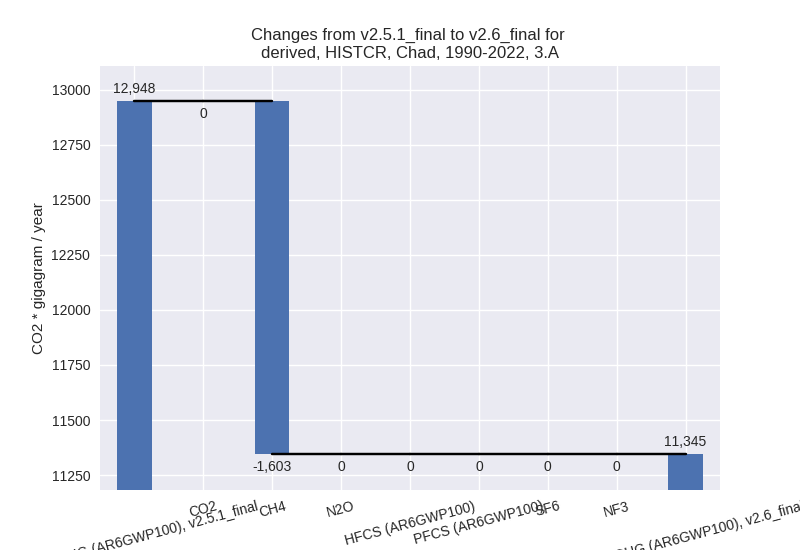
There is no subsector information available in PRIMAP-hist. - M.AG.ELV: Total sectoral emissions in 2022 are
22546.60 Gg CO2 / year which is 48.4% of category M.AG emissions. 2022
Emissions have changed by 0.0% (0.00
Gg CO2 / year). 1990-2022 Emissions have changed by -2.1% (-330.60 Gg CO2 / year). For
1990-2022 the changes per gas
are:
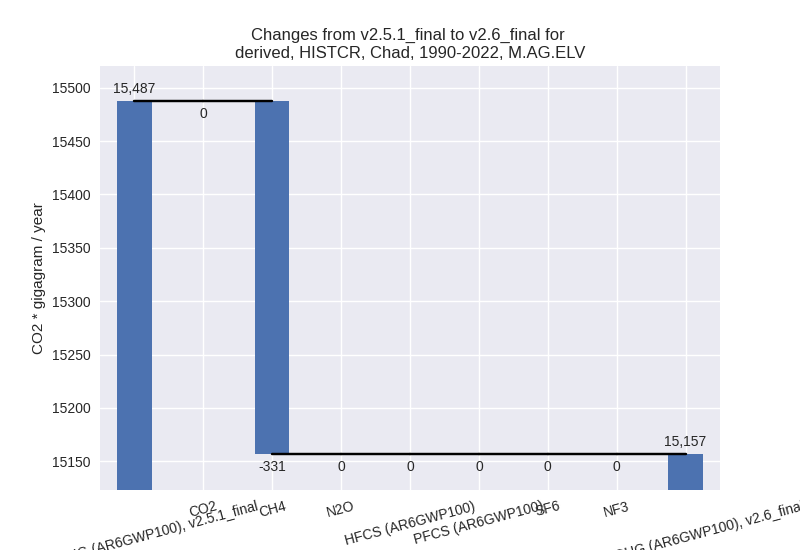
There is no subsector information available in PRIMAP-hist.
- 3.A: Total sectoral emissions in 2022 are 24003.76
Gg CO2 / year which is 51.6% of category M.AG emissions. 2022 Emissions
have changed by 0.0% (0.00 Gg CO2 /
year). 1990-2022 Emissions have changed by -12.4% (-1602.88 Gg CO2 / year). For
1990-2022 the changes per gas
are:
- 4: Total sectoral emissions in 2022 are 631.97 Gg
CO2 / year which is 1.2% of M.0.EL emissions. 2022 Emissions have
changed by -2.2% (-14.27 Gg CO2 /
year). 1990-2022 Emissions have changed by -0.6% (-2.68 Gg CO2 / year). For 2022 the
changes per gas
are:
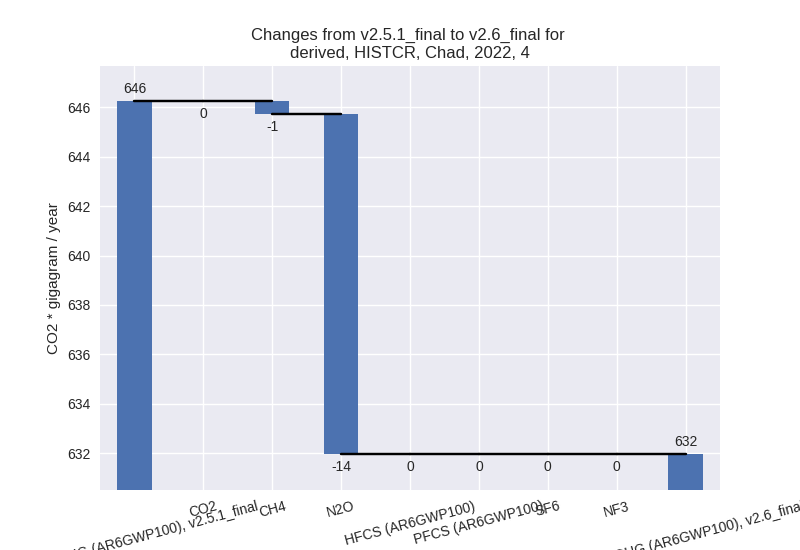
- 5: Total sectoral emissions in 2022 are 351.31 Gg
CO2 / year which is 0.7% of M.0.EL emissions. 2022 Emissions have
changed by 413.5% (282.90 Gg CO2 /
year). 1990-2022 Emissions have changed by 684.2% (400.43 Gg CO2 / year). For 2022
the changes per gas
are:
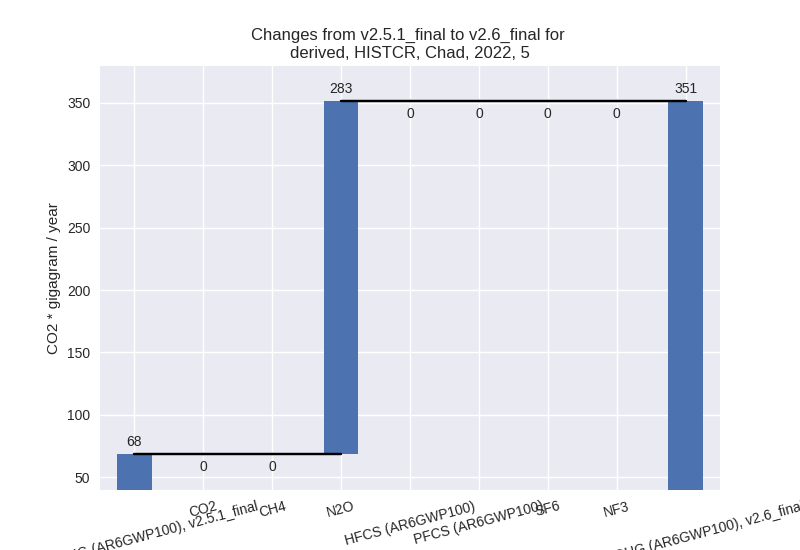
For 1990-2022 the changes per gas are: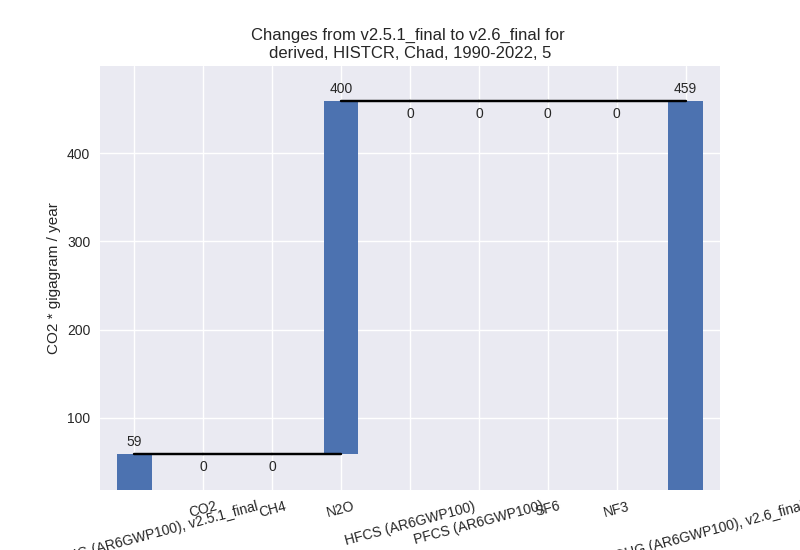
third party scenario (HISTTP):
Most important changes per time frame
For 2022 the following sector-gas combinations have the highest absolute impact on national total KyotoGHG (AR6GWP100) emissions in 2022 (top 5):
- 1: 1.A, CO2 with 422.36 Gg CO2 / year (27.3%)
- 2: 5, N2O with 282.90 Gg CO2 / year (413.5%)
- 3: 4, CH4 with 31.35 Gg CO2 / year (1.1%)
- 4: 4, N2O with 23.20 Gg CO2 / year (11.4%)
- 5: 2, HFCS (AR6GWP100) with 9.60 Gg CO2 / year (1.5%)
For 1990-2022 the following sector-gas combinations have the highest absolute impact on national total KyotoGHG (AR6GWP100) emissions in 1990-2022 (top 5):
- 1: 5, N2O with 400.43 Gg CO2 / year (684.2%)
- 2: 1.A, CO2 with 16.15 Gg CO2 / year (1.6%)
- 3: 4, CH4 with 13.49 Gg CO2 / year (0.8%)
- 4: 4, N2O with 10.03 Gg CO2 / year (8.5%)
- 5: 2, HFCS (AR6GWP100) with 0.29 Gg CO2 / year (0.1%)
Changes in the main sectors for aggregate KyotoGHG (AR6GWP100) are
- 1: Total sectoral emissions in 2022 are 5237.23 Gg
CO2 / year which is 5.2% of M.0.EL emissions. 2022 Emissions have
changed by 8.8% (422.36 Gg CO2 /
year). 1990-2022 Emissions have changed by 0.5% (16.15 Gg CO2 / year). For 2022 the
changes per gas
are:
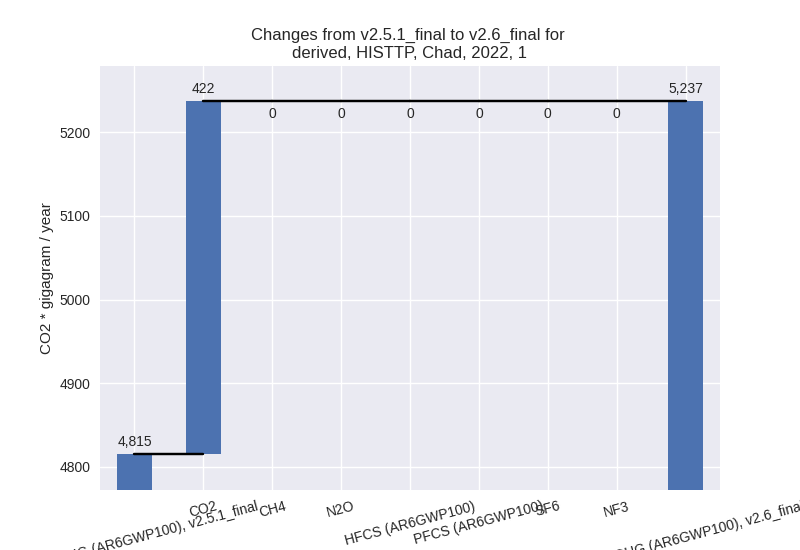
The changes come from the following subsectors:- 1.A: Total sectoral emissions in 2022 are 3309.15
Gg CO2 / year which is 63.2% of category 1 emissions. 2022 Emissions
have changed by 14.6% (422.36 Gg CO2
/ year). 1990-2022 Emissions have changed by 0.8% (16.15 Gg CO2 / year). For 2022 the
changes per gas
are:
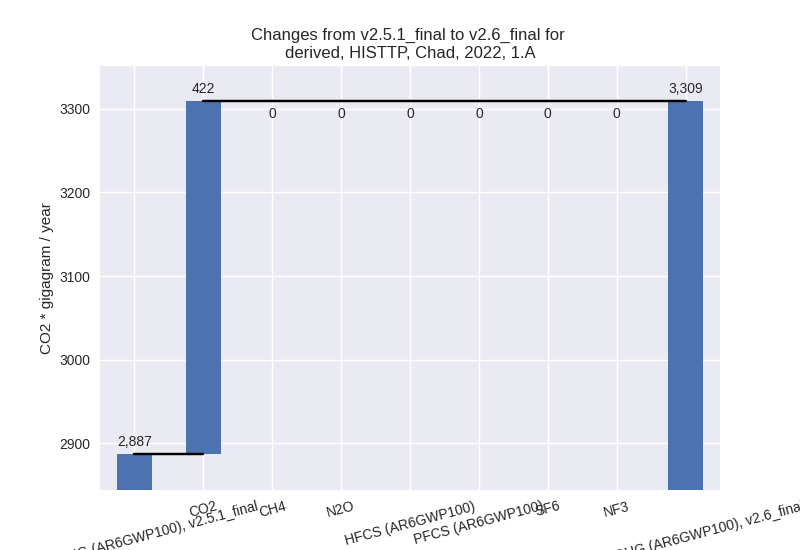
There is no subsector information available in PRIMAP-hist. - 1.B.1: Total sectoral emissions in 2022 are 564.89 Gg CO2 / year which is 10.8% of category 1 emissions. 2022 Emissions have changed by 0.0% (0.00 Gg CO2 / year). 1990-2022 Emissions have changed by 0.0% (0.00 Gg CO2 / year).
- 1.B.2: Total sectoral emissions in 2022 are 1363.18 Gg CO2 / year which is 26.0% of category 1 emissions. 2022 Emissions have changed by 0.0% (0.00 Gg CO2 / year). 1990-2022 Emissions have changed by 0.0% (0.00 Gg CO2 / year).
- 1.A: Total sectoral emissions in 2022 are 3309.15
Gg CO2 / year which is 63.2% of category 1 emissions. 2022 Emissions
have changed by 14.6% (422.36 Gg CO2
/ year). 1990-2022 Emissions have changed by 0.8% (16.15 Gg CO2 / year). For 2022 the
changes per gas
are:
- 2: Total sectoral emissions in 2022 are 909.23 Gg CO2 / year which is 0.9% of M.0.EL emissions. 2022 Emissions have changed by 1.1% (9.60 Gg CO2 / year). 1990-2022 Emissions have changed by 0.1% (0.29 Gg CO2 / year).
- M.AG: Total sectoral emissions in 2022 are 90301.58 Gg CO2 / year which is 90.5% of M.0.EL emissions. 2022 Emissions have changed by 0.0% (0.00 Gg CO2 / year). 1990-2022 Emissions have changed by 0.0% (0.00 Gg CO2 / year).
- 4: Total sectoral emissions in 2022 are 3020.27 Gg CO2 / year which is 3.0% of M.0.EL emissions. 2022 Emissions have changed by 1.8% (54.56 Gg CO2 / year). 1990-2022 Emissions have changed by 1.3% (23.52 Gg CO2 / year).
- 5: Total sectoral emissions in 2022 are 351.31 Gg
CO2 / year which is 0.4% of M.0.EL emissions. 2022 Emissions have
changed by 413.5% (282.90 Gg CO2 /
year). 1990-2022 Emissions have changed by 684.2% (400.43 Gg CO2 / year). For 2022
the changes per gas
are:
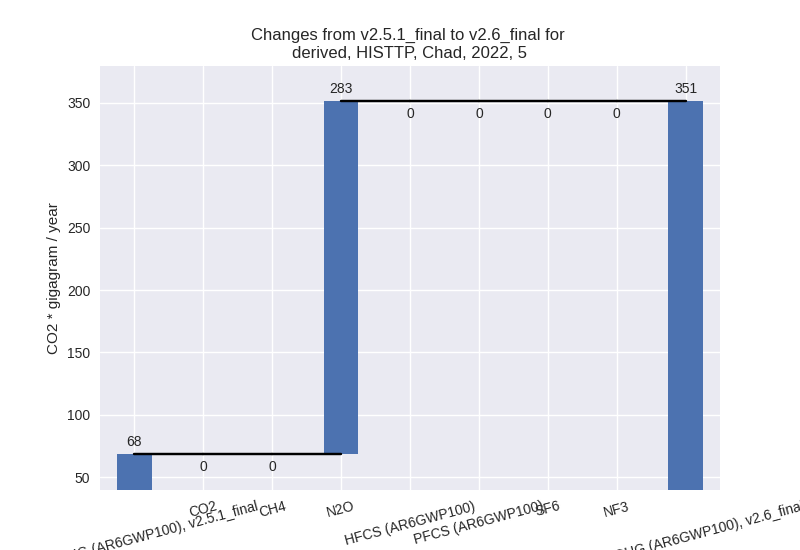
For 1990-2022 the changes per gas are: